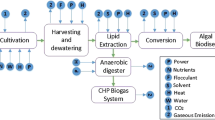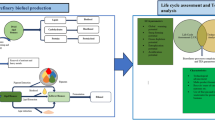Abstract
Purpose
Prospective evaluation of the lifecycle impacts of aviation biofuel production in Abu Dhabi, UAE based on a production system that integrates aquaculture, saltwater agriculture, and mangrove silviculture, termed an Integrated Seawater Energy Agriculture System (ISEAS) in order to investigate its energetic and environmental potential compared to conventional fuels.
Methods
We compare the hydroprocessed renewable jet fuel (HRJ) produced from ISEAS against fossil jet fuel using a life cycle assessment (LCA) methodology. Based on a detailed description of the production process, we use data from a wide-ranging literature review and experimental results from the specific location to make informed assumptions for the range of the process inputs and yields. We then analyze several process configuration scenarios with different ranges.
Results and discussion
ISEAS can produce aviation biofuels, electricity, and food while afforesting coastal desert land, acting as a long-term sink for carbon, minimizing freshwater consumption, and having beneficial land use impacts when compared to fossil jet fuel production. Based on a sensitivity analysis, we show that ISEAS HRJ emits 38 to 68% less greenhouse gases than fossil jet fuel and yields an overall positive net energy balance under all scenarios except one with an extensive use of desalinated water.
Conclusions
ISEAS offers a promising pathway for integrating aquaculture and seawater agriculture in arid regions. It is essentially a process to sustainably augment aquaculture-based products by using its waste as a biofuel resource. Achieving positive emissions results depend critically on minimizing freshwater use, maximizing biomass yield and to a lesser extent the performance of biomass gasification.











Similar content being viewed by others
References
Acosta-Ruiz MJ, Paniagua-Michel J, Olmos-Soto J, Paredes-Escalona E (2011) Primer registro de la utilización de harinas de Salicornia bigelovii y Scomber japonicus en dietas prácticas para el cultivo súper-intensivo de camarón Litopenaeus stylirostris. Lat Am J Aquat Res 39:409–415
Alsobayel A, Al-Batshan H, Albadry M (2002) Effect of Salicornia bigelovii Torr meal and age on egg components of baladi and leghorn laying hens. J King Saud Univ 14:55–62
Al-Yamani W, Kennedy S, Sgouridis S, Yousef LF (2013) A land suitability study for the sustainable cultivation of the halophyte Salicornia bigelovii: the case of Abu Dhabi, UAE. Arid Land Res Manage 27:349–360
Ayala F, O’Leary JW (1995) Growth and physiology of Salicornia bigelovii Torr. at suboptimal salinity. Int J Plant Sci 156:197–205
Bailis R, Yu E (2012) Environmental and social implications of integrated seawater agriculture systems producing Salicornia bigelovii for biofuel. Biofuels 3:555–574
Belal IE, Al-Dosari M (1999) Replacement of fish meal with Salicornia meal in feeds for Nile tilapia Oreochromis niloticus. J World Aquacult Soc 30:285–289
Bouillon S, Borges AV, Castañeda-Moya E, Diele K, Dittmar T, Duke NC et al (2008) Mangrove production and carbon sinks: a revision of global budget estimates. Glob Biogeochem Cycles 22(2). doi:10.1029/2007GB003052
Brown JJ, Glenn EP, Fitzsimmons KM, Smith SE (1999) Halophytes for the treatment of saline aquaculture effluent. Aquaculture 175:255–268
Brown JJ, Cybulska I, Chaturvedi T, Thomsen MH (2014) Halophytes for the production of liquid biofuels. Sabkha ecosystems: vol IV: Cash crop halophyte and biodiversity conservation, Springer, pp 67–72
Buragohain B, Mahanta P, Moholkar VS (2010) Thermodynamic optimization of biomass gasification for decentralized power generation and Fischer-Tropsch synthesis. Energy 35(6):2557–2579
Chaturvedi T, Uratani JM, Thomsen MH, Rodríguez J (2013) Evaluation of pre-treatment conditions of biomass waste from the halophyte Salicornia bigelovii cultivated in sea water
Chmura GL, Anisfeld SC, Cahoon DR, Lynch JC (2003) Global carbon sequestration in tidal, saline wetland soils. Glob Biogeochem Cycles 17(4). doi:10.1029/2002GB001917
Cybulska I, Chaturvedi T, Alassali A, Brudecki GP, Brown JJ, Sgouridis S, Thomsen MH (2014a) Characterization of the chemical composition of the halophyte Salicornia bigelovii under cultivation. Energy Fuel 28:3873–3883
Cybulska I, Chaturvedi T, Brudecki GP, Kádár Z, Meyer AS, Baldwin RM, Thomsen MH (2014b) Chemical characterization and hydrothermal pretreatment of Salicornia bigelovii straw for enhanced enzymatic hydrolysis and bioethanol potential. Bioresour Technol 153:165–172
Dodd RS, Blasco F, Rafii ZA, Torquebiau E (1999) Mangroves of the United Arab Emirates: ecotypic diversity in cuticular waxes at the bioclimatic extreme. Aquat Bot 63:291–304
Duarte CM, Middelburg JJ, Caraco NF (2005) Major role of marine vegetation on the oceanic carbon cycle. Biogeosciences 2:1–8
Duarte CM, Dennison WC, Orth RJ, Carruthers TJ (2008) The charisma of coastal ecosystems: addressing the imbalance. Estuar Coasts 31:233–238
EIA (2011) Table 3.3 Consumer price estimates for energy by source. 1970–2007 (Dollars per Million Btu)
Glenn EP, O’Leary JW, Watson MC, Thompson TL, Kuehl RO (1991) Salicornia bigelovii Torr.: an oilseed halophyte for seawater irrigation. Science 251:1065–1067
Glenn E, Squires V, Olsen M, Frye R (1993) Potential for carbon sequestration in the drylands. Water Air Soil Pollut 70:341–355
Glenn E, Hicks N, Riley J, Swingle S (1995) Seawater irrigation of halophytes for animal feed. Enviromental Research Laboratory, Tucson Arizona, pp. 221–234
Glenn E, Miyamoto S, Moore D, Brown JJ, Thompson TL, Brown P (1997) Water requirements for cultivating Salicornia bigelovii Torr. with seawater on sand in a coastal desert environment. J Arid Environ 36:711–730
Glenn EP, Jed Brown J, O’Leary JW (1998) Irrigating crops with seawater. Scientific American-American Edition 279:76–81
Glenn EP, Brown JJ, Blumwald E (1999) Salt tolerance and crop potential of halophytes. Crit Rev Plant Sci 18:227–255
Goodfriend WL, Olsen MW, Frye RJ (1998) Decomposition of seawater-irrigated halophytes: implications for potential carbon storage. Plant Soil 202(2):241–250
Grattan S, Benes S, Peters D, Diaz F (2008) Feasibility of irrigating Pickleweed (Torr) with hyper-saline drainage water. J Environ Qual 37(5 Supplement):S-149–S-156
Gronroos J, Seppala J, Silvenius F, Makinen T (2006) Life cycle assessment of Finnish cultivated rainbow trout. Boreal Environ Res 11:401
Hertwich EG, Zhang X (2009) Concentrating-solar biomass gasification process for a 3rd generation biofuel. Environ Sci Technol 43(11):4207–4212
Hsu DD (2012) Life cycle assessment of gasoline and diesel produced via fast pyrolysis and hydroprocessing. Biomass Bioenergy 45(C):41–47. doi:10.1016/j.biombioe.2012.05.019
Ibarrola R, Shackley S, Hammond J (2012) Pyrolysis biochar systems for recovering biodegradable materials: a life cycle carbon assessment. Waste Manag 32(5):859–868
IndexMundi (2011). Index Mundi - Country Facts
Iribarren D, Peters JF, Dufour J (2012) Life cycle assessment of transportation fuels from biomass pyrolysis. Fuel 97(C):812–821. doi:10.1016/j.fuel.2012.02.053
ISO (2006a) Environmental management - life cycle assessment - principles and framework. International Organization of Standardization (ISO) 14040
ISO (2006b) Environmental management - life cycle assessment - requirements and guidelines. International Organization of Standardization (ISO) 14044
Juarez LM, Martinez-Cordero FJ (2004) Operating costs and health management strategies in shrimp hatcheries. Aquaculture Economics & Management 8(3–4):193–200
Kinder JD, Rahmes T (2009) Evaluation of bio-derived synthetic paraffinic kerosene (Bio-SPK). Sustainable biofuels research & technology program, The Boeing Company
Klingshirn CD, DeWitt M, Striebich R, Anneken D, Shafer L, Corporan E, Wagner M, Brigalli D (2012) Hydroprocessed renewable jet fuel evaluation, performance, and emissions in a T63 turbine engine. J Eng Gas Turb Power 134:051506
Kluts IN, Potting J, Bosma RH, Phong LT, Udo HM (2012) Environmental comparison of intensive and integrated agriculture–aquaculture systems for striped catfish production in the Mekong Delta, Vietnam, based on two existing case studies using life cycle assessment. Rev Aquaculture 4:195–208
Kole C, Joshi CP, Shonnard DR (2012) Handbook of bioenergy crop plants, CRC Press
Kristensen E, Bouillon S, Dittmar T, Marchand C (2008) Organic carbon dynamics in mangrove ecosystems: a review. Aquat Bot 89:201–219
Kutty M, Murugapoopathy G, Krishnan T (1971) Influence of salinity and temperature on the oxygen consumption in young juveniles of the Indian prawn Penaeus indicus. Mar Biol 11:125–131
Lim CE, Webster CD (2006) Tilapia: biology, culture, and nutrition, Food Products Press
Lonard RI, Judd FW, Stalter R (2012) The biological flora of coastal dunes and wetlands: Salicornia bigelovii J. Torrey. J Coast Res 28(3):719–725. doi:10.2112/JCOASTRES-D-11-00125.1
Lv P, Yuan Z, Wu C, Ma L, Chen Y, Tsubaki N (2007) Bio-syngas production from biomass catalytic gasification. Energy Convers Manag 48(4):1132–1139
Masters DG, Benes SE, Norman HC (2007) Biosaline agriculture for forage and livestock production. Agric Ecosyst Environ 119:234–248
Maurice LQ, Lander H, Edwards T, Harrison W (2001) Advanced aviation fuels: a look ahead via a historical perspective. Fuel 80:747–756
Mittelbach M, Remschmidt C (2004) Biodiesel: the comprehensive handbook. Martin Mittelbach
NOAA (2011) NOAA U.S. foreign trade
Pelletier N, Tyedmers P, Sonesson U, Scholz A, Ziegler F, Flysjo A, Kruse S, Cancino B, Silverman H (2009) Not all salmon are created equal: life cycle assessment (LCA) of global salmon farming systems. Environ Sci Technol 43:8730–8736
Pimentel D, Patzek T (2008) Ethanol production using corn, switchgrass and wood; biodiesel production using soybean. Biofuels, solar and wind as renewable energy systems, Springer, pp 373–394
Ponce-Palafox JT, Ruiz-Luna A, Castillo-Vargasmachuca S, García-Ulloa M, Arredondo-Figueroa JL (2011) Technical, economics and environmental analysis of semi-intensive shrimp (Litopenaeus vannamei) farming in Sonora, Sinaloa and Nayarit states, at the east coast of the Gulf of California, México. Ocean Coast Manage 54(7):507–513
Popma TJ, Lovshin LL (1996) Worldwide prospects for commercial production of tilapia. International center for aquaculture and aquatic environments
Putnam D, Oplinger E, Hicks D, Durgan B, Noetzel D, Meronuck R, Doll J, Schulte E (1990) Sunflower. Alternative field crops manual. University of Wisconsin, Cooperative Extension, Madison
RSB (2013) Principles and criteria for sustainable biofuel production V2.1. Roundtable for sustainable biofuels. Lausanne. rsb.org/pdfs/standards/11-03-08%20RSB%20PCs%20Version%202.1.pdf
RSB (2011) RSB GHG Calculation methodology
Schneider O, Sereti V, Eding E, Verreth J (2005) Analysis of nutrient flows in integrated intensive aquaculture systems. Aquac Eng 32:379–401
Skone TJ, Gerdes K (2008) Development of baseline data and analysis of life cycle greenhouse gas emissions of petroleum-based fuels. National energy technology laboratory, Nov 26
Stephenson AL, Kazamia E, Dennis JS, Howe CJ, Scott SA, Smith AG (2010) Life-cycle assessment of potential algal biodiesel production in the United Kingdom: a comparison of raceways and air-lift tubular bioreactors. Energy Fuel 24(7):4062–4077
Stratton R, Wong H, Hileman J (2010) Life cycle greenhouse gas emissions from alternative jet fuels (Version 1.1). Partner Report No. PARTNER-COE-2010-001. June, 2010. (http://web.mit.edu/aeroastro/partner/reports/proj28/partner-proj28-2010-001.pdf)
Sun W (2009) Life cycle assessment of indoor recirculating shrimp aquaculture system. University of Michigan, Ann Arbor
Swanson RM, Platon A, Satrio JA, Brown RC (2010) Techno-economic analysis of biomass-to-liquids production based on gasification. Fuel 89(supple 1):S11–S19
Swingle R, Glenn E, Squires V (1996) Growth performance of lambs fed mixed diets containing halophyte ingredients. Anim Feed Sci Tech 63:137–148
Timmons MB, Ebeling JM, Wheaton FW, Summerfelt ST, Vinci BJ (2002) Recirculating aquaculture systems, 2nd edn. Cayuga aqua ventures llc
van Vliet OPR, Faaij APC, Turkenburg WC (2009) Fischer–Tropsch diesel production in a well-to-wheel perspective: a carbon, energy flow and cost analysis. Energy Convers Manag 50(4):855–876
Vinatea L, Muedas W, Arantes R (2011) The impact of oxygen consumption by the shrimp Litopenaeus vannamei according to body weight, temperature, salinity and stocking density on pond aeration: a simulation. Acta Scientiarum: Biological Sciences 33(2):1–8
Warshay B, Pan J, Sgouridis S (2011) Aviation industry’s quest for a sustainable fuel: considerations of scale and modal opportunity carbon benefit. Biofuels 2:33–58
Wilson GR III, Edwards T, Corporan E, Freerks RL (2013) Certification of alternative aviation fuels and blend components. Energy Fuel 27:962–966
Zerai DB, Glenn EP, Chatervedi R, Lu Z, Mamood AN, Nelson SG, Ray DT (2010) Potential for the improvement of Salicornia bigelovii through selective breeding. Ecol Eng 36:730–739
Zhong ZW, Song B, Zaki MBM (2010) Life-cycle assessment of flash pyrolysis of wood waste. J Clean Prod 18(12):1177–1183
Acknowledgments
This work was supported by a Boeing Company grant and the Sustainable Bioengy Research Consortium of Masdar Institute. We acknowledge the contribution of Dr. Michael Timmons of Cornell Univesity and Edward P. Glenn of the University of Arizona for providing insights on halophyte cultivation.
Author information
Authors and Affiliations
Corresponding author
Additional information
Responsible editor: Seungdo Kim
The original version of this article was revised: The name of the author J. Jed Brown was rendered wrongly.
An erratum to this article is available at http://dx.doi.org/10.1007/s11367-016-1240-4.
Electronic supplementary material
ESM 1
(XLSX 405 kb)
Rights and permissions
About this article
Cite this article
Warshay, B., Brown, J.J. & Sgouridis, S. Life cycle assessment of integrated seawater agriculture in the Arabian (Persian) Gulf as a potential food and aviation biofuel resource. Int J Life Cycle Assess 22, 1017–1032 (2017). https://doi.org/10.1007/s11367-016-1215-5
Received:
Accepted:
Published:
Issue Date:
DOI: https://doi.org/10.1007/s11367-016-1215-5




